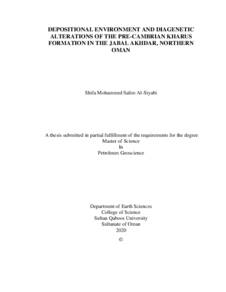وثيقة
Depositional environment and diagenetic alterations of the PreCambrian kharus formation in the Jabal Akhdar, Northern Oman.
الناشر
Sultan Qaboos University.
ميلادي
2020
اللغة
الأنجليزية
الملخص الإنجليزي
In the Jabal Akhdar of northern Oman, the late Neoproterozoic Kharus Formation is timeequivalent to the gas-producing reservoir of the Buah Formation in the subsurface in
Oman Interior Basin. This thesis project provides a detailed description of the depositional
microfacies distribution of Kharus Formation and the diagenetic alterations and their
impacts on reservoir quality of the studied Kharus Formation in two outcrops: Wadi Bani
Awf and Wadi Bani Kharus in the Jabal Akhdar area. Detailed sedimentological
descriptions of Wadi Bani Awf and Wadi Bani Kharus sections constructed to provide a
better understanding of depositional microfacies distribution. Petrographical (Thinsections, SEM and CL) and geochemical analyses (EDS, XRD and XRF) were done to
investigate the diagenetic alterations and their effects on the reservoir quality.
The Kharus carbonates conformably overlie Mu'aydin Formation clastics with a
transitional contact. In Wadi Bani Awf, the upper boundary of the Kharus Formation
characterized by conformable contact with Fara Formation (Ara Group). However, in
Wadi Bani Kharus, it defined by angular unconformable contact with Permian Saiq
Formation. This study indicates that the Kharus Formation accumulated on a distally
steepened storm-dominated ramp showing an overall shallowing-upward trend. The lower
Kharus reflects the deposition in the outer ramp environment, where the thick mudstone
microfacies with microbial lamination deposited. The mudstone microfacies do not show
any evidence of the presence of evaporitic materials or desiccation features this indicates
that the deposition took place at relatively deeper-water settings below the storm wave
vi
base and under quiet conditions. In addition, the outer ramp characterized by the presence
of poorly sorted, matrix-supported floatstone-rudstone microfacies. The presence of this
thick floatstone-rudstone interval with its shallow-water-derived clasts indicates it
deposited in shallow waters within inner-mid ramp or re-deposited in the outer ramp area.
The upper Kharus dominates by the presence of ooidal-peloidal grains and the m- scale
stromatolites that indicate the deposition in inner-mid ramp environment. These suggest
that the deposition had taken place under high-energy conditions above the fair-weather
wave base.
The main diagenetic processes that affected the Kharus Formation during three stages of
diagenesis; eo-, meso- and telodiagenesis were cementation, mechanical and chemical
compaction, micritization and dissolution. In eodiagenetic stage, the reservoir quality of
the Kharus Formation affected by the mechanical compaction, dissolution of unstable
grains and precipitation of pyrite. However, chemical compaction may occur in the
mesodiagenetic stage. In addition, cementation by calcite and dolomite may have occurred
in eo- and mesodiagenesis stages. Also, in oxic environment, iron oxide occurs at the early
and later stages of diagenesis. Finally, these diagenetic alterations processes have affected
the reservoir quality of the Kharus Formation negatively.
المجموعة
URL المصدر
قالب العنصر
الرسائل والأطروحات الجامعية

